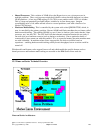
As noted above, many distributions are based on the 2.95 gcc compiler. The more recent 3.2 gcc is also
used by some distributions. Results there shows some variability and not much net improvement. To the
extent it improves, the gap with ILE should close somewhat. Floating point performance is improved, but
proportionately. None of the recommendations in terms of Linux versus other platforms change because
the improvement is too inconsistent to alter the rankings, though it bears watching in the future as gcc has
more room to improve. This is comparing at -O3 as per the prior section's recommendations.
13.6 Value of Virtual LAN and Virtual Disk
Virtual LAN
Virtual LAN is a high speed interconnect mechanism which appears to be an ordinary ethernet LAN as
far as Linux is concerned.
There are several benefits from using Virtual LAN:
y Performance. It functions approximately on a par with Gigabit ethernet (see previous section,
Network Primitives).
y Cost. Since it uses built-in processor facilities accessed via the Hypervisor (running on the hosting
OS/400 partition), there are no switches, hubs, or wires to deal with. At gigabit speeds, these costs
can be significant.
y Simplification and Consolidation. It is easy to put multiple Linux partitions on the same Virtual
LAN, achieving the same kinds of topologies available in the real world. This makes Virtual LAN
ideal for server consolidation scenarios.
The exact performance of Virtual LAN, as is always the case, varies based on items like average IP
packet size and so on. However, in typical use, we've observed speeds of 200 to 400 megabits per second
on 600 MHz processors. The consumption on the OS/400 side is usually 10 per cent of one CPU or less.
Virtual Disk
Virtual Disk simulates an arbitrarily sized disk. Most distributions make it "look like" a large, single IDE
disk, but that is an illusion. In reality, the disks used to implement it are based on OS/400 Network
Storage (*NWSSTG object) and will be allocated from all available (SCSI) disks on the Auxiliary
Storage Pool (ASP) containing the Network Storage. By design, OS/400 Single Level Store always
"stripes" the data, so Linux files of a nontrivial size are accordingly spread over multiple physical disks.
Likewise, a typical ASP on OS/400 will have RAID-5 or mirrored protection, providing all the benefits of
these functions without any complexity on the Linux side at all.
Thus, the advantages are:
y Performance. Parallel access is possible. Since the data is striped, it is possible for the data to be
concurrently read from multiple disks.
y Reduction in Complexity. Because it looks like one large disk to Linux, but is typically implemented
with RAID-5 and striping, the user does not need to deploy complex strategies such as Linux Volume
Management and other schemes to achieve RAID-5 and striping. Moreover, obtaining both strategies
(which are, in effect, true by default in OS/400) is more complex still in the Linux environment.
IBM i 6.1 Performance Capabilities Reference - January/April/October 2008
© Copyright IBM Corp. 2008 Chapter 13 - Linux 184


















